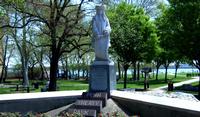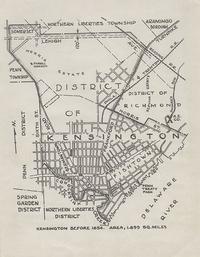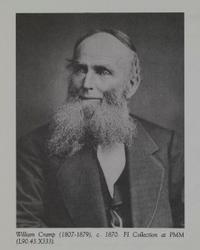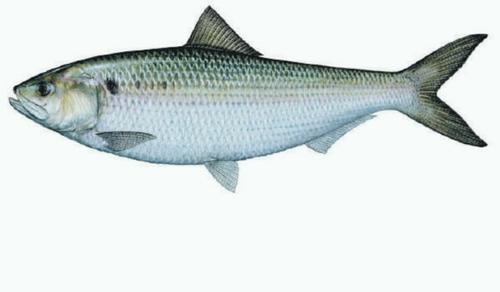 The Fish
The Fish
It all started with the fish. Like salmon, shad are born in fresh water, spend several years growing in the ocean, then return to their birthplace to spawn. The largest breeding ground for American shad was the Delaware River estuary. Long before Europeans reached its shores, the Leni-Lenape tribe settled along the Delaware to take advantage of this bounty, using nets made from tall grass to gather the fish into shallows where they were easily speared. The Lenape Turtle clan settled on the western shore in a spot that became the meeting place for all the Lenape chiefs: the "Place of Council," or Shackamaxon. They were joined there in the 1630s by Swedish families, the Cocks, the Lyckans, and the Rambos, who became the first European settlers in Pennsylvania.
In 1682, William Penn arrived to survey his new land and establish peaceful relations with the Lenape. He met with Chief Tamanend in Shackamaxon under an elm tree and they negotiated a treaty. Penn Treaty Park, at the intersection of Beach Street and Delaware Avenue Park, commemorates this event. There is no written record of the treaty, but the Atwater Kent Museum exhibits a wampum belt that commemorates the meeting. Once these negotiations were finished, Penn encouraged his employees and associates to offer the Swedes generous sums for their land and settle there.
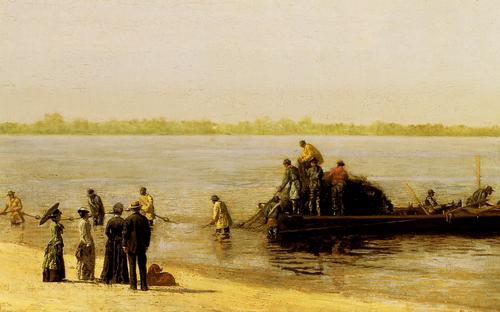
Penn was soon followed by English and German settlers and Shackamaxon grew and evolved into Kensington, Port Richmond, and Fishtown. Most of the Germans were fishermen and settled along the shore between Gunner’s Run and Cohocksink Creek. They stuck together, marrying into each other’s families and staying in the neighborhood for several generations. The Bennetts, Cramps, Faunces, Gossers, and Rices were the main fishing families and you can find many of them buried in Palmer Cemetery. Over time they bought or leased parts of the shore and came to control fishing in the river. By 1875, all the fisheries on both sides of the 100-mile stretch of river between Trenton and Delaware Bay were controlled by these five Fishtown families.
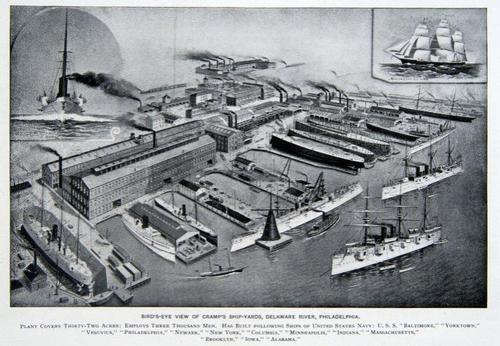
But Fishtown was not just about fish—18th century Fishtown was home to several successful industries, including calico printing, glassmaking, industrial chemical manufacturing, and especially shipbuilding.
In the 1700s, Philadelphia was primarily a port. As the Philadelphia waterfront became more crowded and expensive, shipbuilders and ancillary businesses moved north. This development was facilitated by visionary British merchant Anthony Palmer who in 1729, consolidated the original Shackamaxon site with substantial acreage to the north and west. He named his holdings Kensington, after London’s Kensington Palace. Palmer then sold sites along the river to eager shipbuilders. By the early 1800s, these businesses employed over half of Fishtown’s workers.
The most successful shipbuilder of all was the son of a Fishtown fisherman. William Cramp’s family originated in Germany with the name of Krampf. They came to Philadelphia in the early 1700s and became fishermen. Like many other immigrants, they changed their family name at the time of the Revolution in order to sound more American. William was born in 1807, went to public schools, and worked as a fisherman until he was apprenticed to the shipbuilder, William Grice. Cramp married into a prominent shipbuilding family and opened his first shipyard in 1830 at the site where Susquehanna Street met the Delaware River. It was later moved and eventually covered the entire waterfront from Norris to Cumberland Streets. William Cramp & Sons became one of the great shipyards of the world and at its peak in the 1890s employed 5,000 men, most from Fishtown, Port Richmond, and Kensington. Cramp & Sons built battleships, cruisers, cargo ships, and luxurious passenger ships for companies and countries around the world. By the time of his death in 1879, William Cramp had overseen the building of 225 ships.
Read more:
- Remembering Kensington & Fishtown: Philadelphia's Riverward Neighborhoods by Kenneth W. Milano
-
The Founding Fish by John McPhee
-
Palmer Cemetery and the Historic Burial Grounds of Kensington & Fishtown by Kenneth W. Milano
-
Hidden History of Kensington & Fishtown by Kenneth W. Milano
-
Fishtown by Kevin Colden
-
New Kensington and Fishtown Redevelopment Area Plan by Philadelphia City Planning Commission
-
"Traces of Lenapehoking: Native American Sites on the Philadelphia Waterfront" by Douglas Mooney
Watch:
Uncovered History: Documents Paint Picture of Pre-Revolutionary Fishtown and Palmer Cemetery
Have a question for Free Library staff? Please submit it to our Ask a Librarian page and receive a response within two business days.

